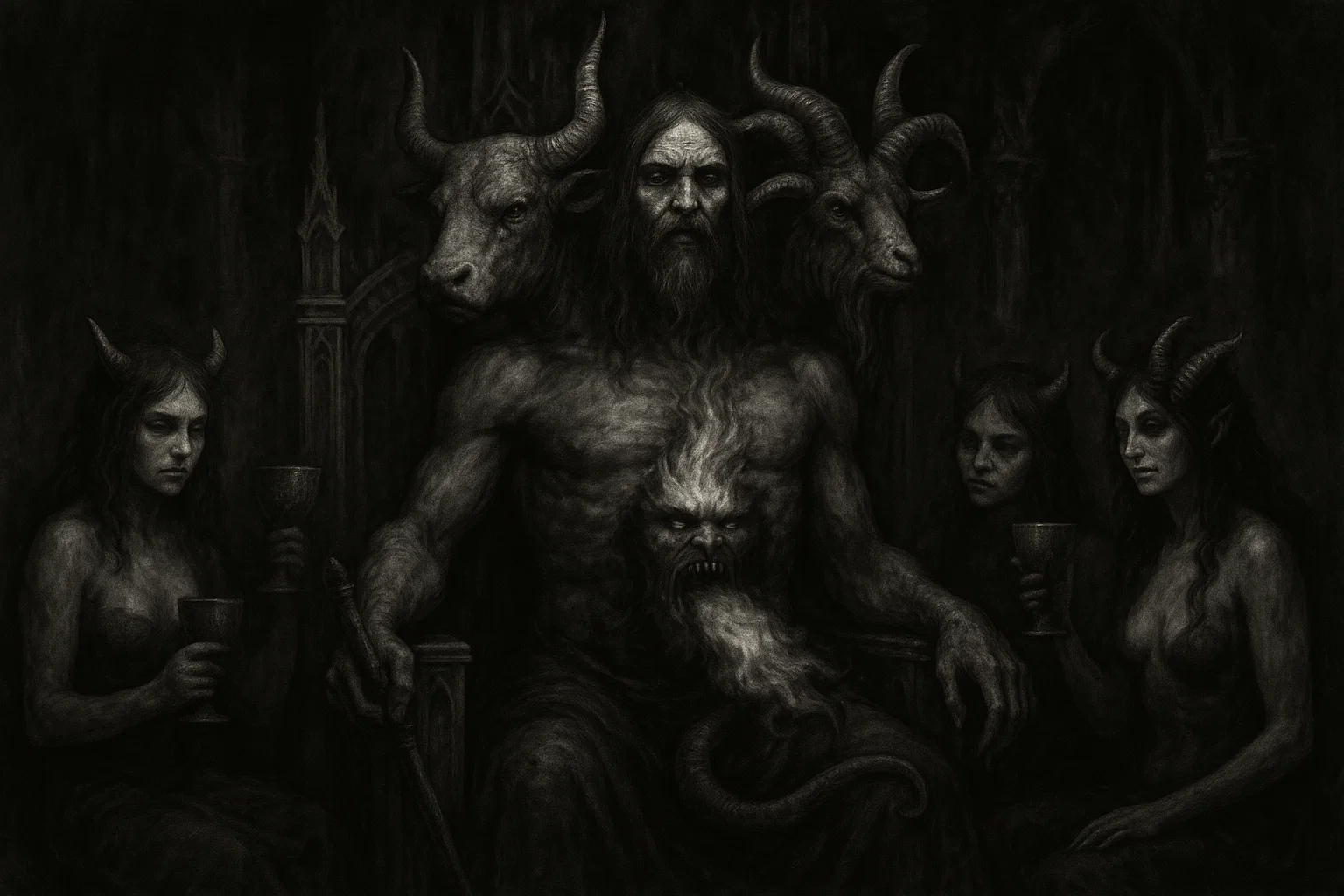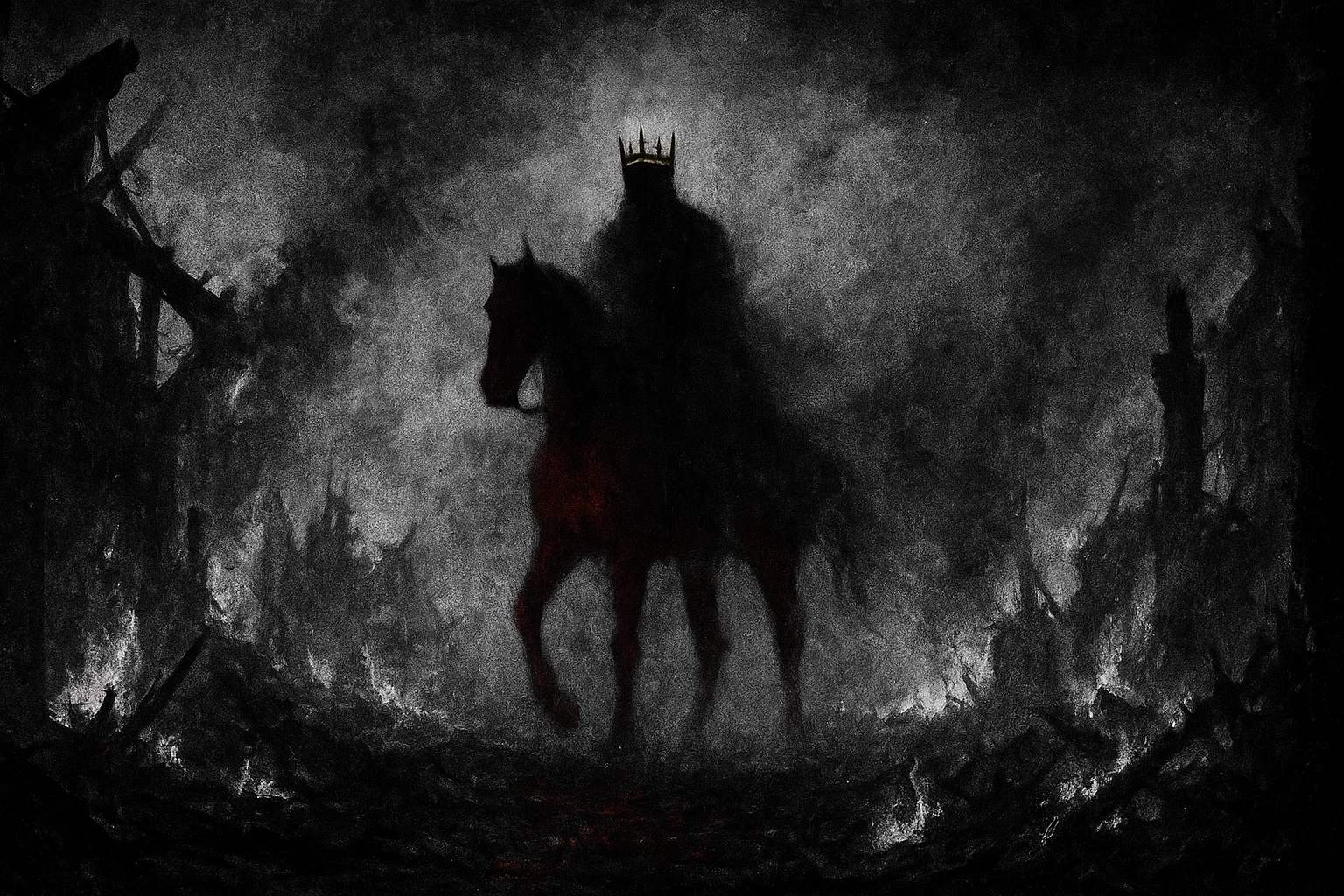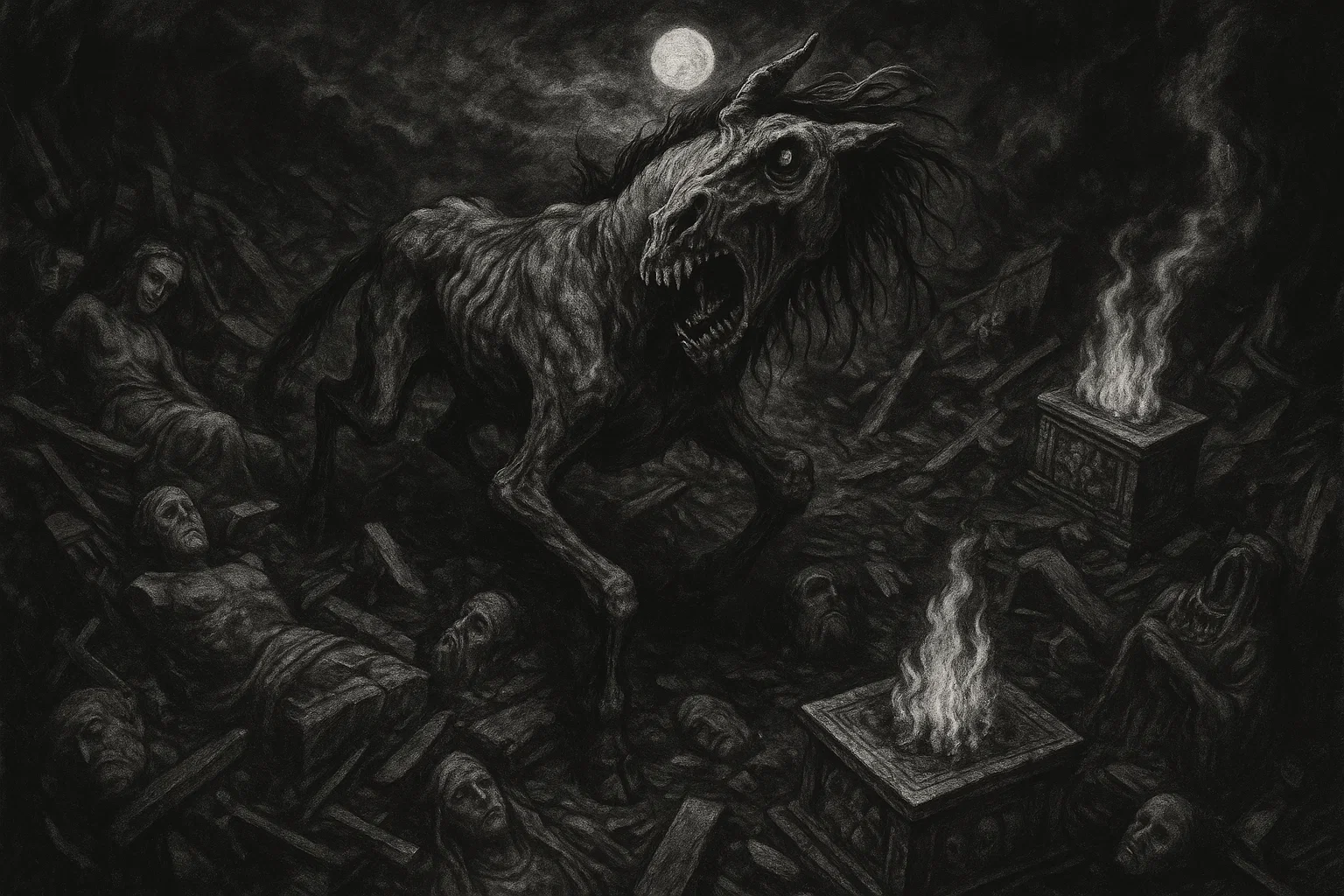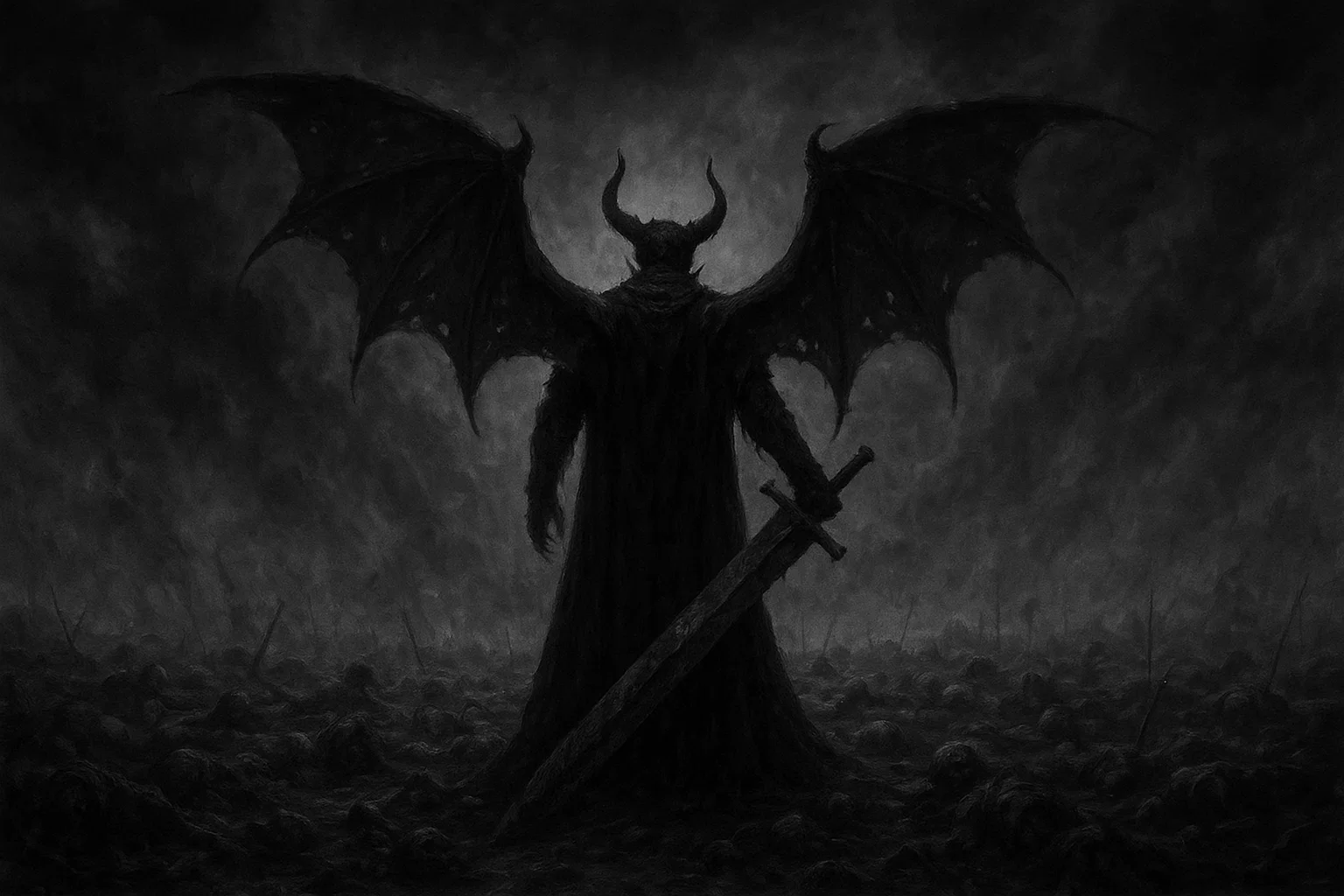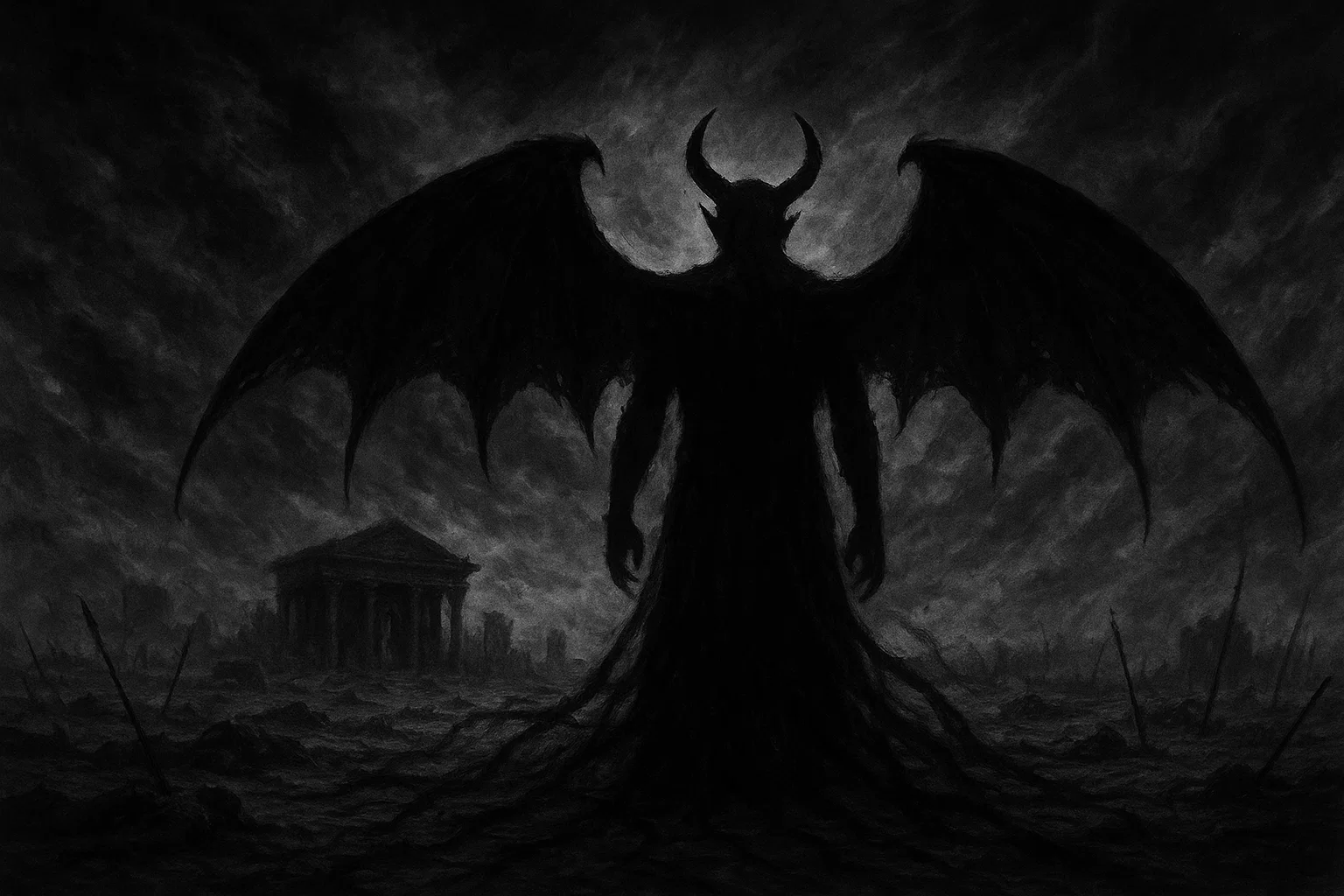In the shadowed annals of demonology, few figures loom as large as Asmodeus, the king of demons whose name evokes both dread and fascination.
Known as Ashmedai in Jewish lore and Asmoday in occult grimoires, he is a master of lust, wrath, and hidden knowledge. From the ancient Book of Tobit to the medieval Lesser Key of Solomon, Asmodeus has been depicted as a tempter who sows discord and a sage who unveils secrets.
Commanding 72 legions of spirits, he holds a prominent place in the hierarchy of hell. His legendary clash with King Solomon, where cunning met divine wisdom, remains a cornerstone of his mythos. What drives this enigmatic demon? Explore his origins, powers, and enduring legacy to uncover the truth behind Asmodeus.
Table of Contents
Key Information
| Attribute | Description |
|---|---|
| Name | Asmodeus (Ashmedai, Asmoday, Asmodee, Sydonay, Hashmedai) |
| Title | Great King, Prince of Lust, One of Seven Princes of Hell |
| Element | Fire |
| Direction | East (under Amaymon) |
| Hierarchy | First and choicest under Amaymon; one of seven princes of Hell |
| Servitors | Commands 72 legions of spirits |
| Powers | Incites lust and marital discord; teaches arithmetic, astronomy, geometry, handicrafts; grants invisibility; reveals and guards treasures; oversees gambling; aids revenge |
| Appearance | Three heads (bull, man, ram), serpent’s tail, flames from mouth, webbed goose-like feet; rides an infernal dragon; holds a lance with a banner; alternatively, a young man with a limp and rooster leg |
| Etymology | From Avestan aēšma-daēva (wrath demon); possibly Hebrew asham (guilt) and dai (judge) |
| Associated Figures | Amaymon (superior), Solomon (adversary), Raphael (countering angel), Lilith (consort or mother) |
| Role | Tempts mortals with lust and wrath; imparts knowledge; leads infernal legions |
| Symbolism | Fire (passion, destruction), three heads (multiplicity, power), dragon (dominion), rooster (lust) |
| Weaknesses | Vulnerable to fish gall smoke (per Book of Tobit and Testament of Solomon); countered by St. John or Raphael |
Etymology
Where does the name Asmodeus come from? The name Asmodeus is a linguistic mosaic, reflecting the demon’s complex origins across ancient cultures and mythologies.
Its primary root is widely accepted to be the Avestan aēšma-daēva, from the Zoroastrian tradition of ancient Persia.
In Avestan, aēšma translates to “wrath,” “rage,” or “fury,” while daēva denotes a “demon” or “divine being,” positioning Asmodeus as a personification of chaotic anger and destructive impulse. This connection ties him to the Zoroastrian cosmology, where Aeshma Daeva is a malevolent spirit opposing the forces of good, particularly Sraosha, the angel of obedience.
The Jewish Encyclopedia notes that Zoroastrian influences likely shaped Jewish demonology during the Babylonian Exile (6th century BCE), suggesting that Asmodeus’s name and character were adapted from Persian mythology into Jewish lore.
You May Also Like: Smurl Family Haunting: A Demonic Nightmare in Pennsylvania
In Jewish tradition, Asmodeus is known as Ashmedai, a name that offers further etymological clues. Scholars propose that Ashmedai may derive from Hebrew roots asham (meaning “guilt” or “sin”) and dai (meaning “judge” or “sufficient”), implying a role as a demon who incites moral guilt or judges human failings.
This interpretation aligns with his depiction in the Book of Tobit, where he disrupts marriages through obsessive desire, and in the Talmud, where he challenges human righteousness.
Alternatively, some sources suggest a connection to the Hebrew shamad (to destroy), emphasizing his destructive tendencies. The variation Hashmedai appears in later Jewish folklore, potentially intensifying the destructive connotation by linking to hashmad (annihilation).
The name’s evolution across cultures yields additional variants: Asmoday and Asmodee in medieval grimoires like the Lesser Key of Solomon and Pseudomonarchia Daemonum, and Sydonay in Johann Weyer’s writings, possibly a corruption or intentional esoteric alias.
Some scholars, as cited in the Dictionnaire Infernal, propose a link to the Persian Khashm-dev, a later form of Aeshma, reinforcing the wrathful archetype. Another intriguing theory connects Asmodeus to the Semitic shamdan, a term for a torch or flame, aligning with his fiery element and flame-vomiting depiction in grimoires.
This multiplicity of origins—spanning Avestan, Hebrew, and Semitic roots—underscores Asmodeus’s role as a transcultural figure, embodying wrath, guilt, and destruction.
Beyond linguistic roots, the name’s esoteric significance is notable. In Kabbalistic traditions, names hold power, and Asmodeus’s various appellations may reflect different aspects of his influence.
For instance, Ashmedai in the Talmud portrays a cunning, almost human-like demon, while Asmoday in occult texts emphasizes his regal authority.
The question What is the true name of Asmodeus? persists in occult circles, as each variant carries unique ritual implications. This etymological richness not only highlights Asmodeus’s ancient pedigree but also his adaptability, making him a central figure in demonology’s diverse tapestry.
Historical and Mythological Background
Asmodeus’s origins are deeply rooted in the cultural crossroads of the ancient Near East, where Persian, Jewish, and later Christian traditions converged.
His name and character likely draw from Aeshma Daeva, the Zoroastrian demon of wrath and chaos, whose influence permeated Jewish thought during the Babylonian Exile (6th century BCE). The Jewish Encyclopedia suggests that Persian beliefs shaped Jewish demonology, with Asmodeus embodying the lascivious and wrathful qualities of evil spirits prevalent in Parseeism.
In Jewish tradition, Asmodeus first appears in the Book of Tobit (circa 3rd–2nd century BCE), a deuterocanonical text. Here, he is a demon smitten with Sarah, daughter of Raguel, killing her seven husbands on their wedding nights out of jealousy.
Tobias, guided by the angel Raphael, defeats Asmodeus using smoke from a fish’s gall, driving him to Egypt where Raphael binds him. This narrative establishes Asmodeus as a figure of lust and disruption, countered by divine intervention.
The Talmud elevates Asmodeus to the king of demons, or shedim, in Jewish folklore. Beyond his role in the Solomon narrative, he appears in stories like Baba Metzia 83b, where he interacts with rabbis, displaying both cunning and supernatural knowledge.
His portrayal blends malevolence with a curious humanity, as he aids the righteous while mocking the foolish.
In Christian demonology, Asmodeus’s role crystallized during the Middle Ages. The Malleus Maleficarum (1486) identifies him as the demon of lust, a view echoed by Sebastien Michaelis, who names St. John as his adversary.
You May Also Like: Is the Plantation House Haunting in Prattville Real? Witnesses Say Yes
Peter Binsfeld’s 1589 classification of demons assigns Asmodeus to lust, one of the seven deadly sins, cementing his place among the seven princes of Hell. Renaissance grimoires, such as the Lesser Key of Solomon and Pseudomonarchia Daemonum, describe him as a Great King under Amaymon, teaching sciences and granting invisibility, reflecting his dual nature as tempter and sage.
The Dictionnaire Infernal (1818) by Collin de Plancy further enriches his iconography, depicting him with a man’s breast, a rooster leg, and a lion with dragon wings, symbolizing lust and revenge.
Some Catholic theologians compared him to Abaddon, the angel of the abyss, while others saw him as a prince of revenge, highlighting his versatility in demonological lore.
Asmodeus’s connections extend to other mythological figures. Some traditions link him to Lilith, either as her husband or son, tying him to the “mother of succubi” and reinforcing his association with sexual temptation. His role in Islamic tradition is less clear, but the Quran’s reference to a “puppet” in Surah Ṣād (verses 30–40) is interpreted by some exegetes as Asmodeus (Sakhr), suggesting a demonic figure in Solomon’s court.
This rich tapestry of influences—from Zoroastrian wrath to Jewish folklore and Christian demonology—positions Asmodeus as a multifaceted figure, embodying the eternal struggle between desire and morality across cultures.
Asmodeus and King Solomon
The legendary encounter between Asmodeus and King Solomon is a cornerstone of Jewish demonology, detailed in the Babylonian Talmud (Gittin 68a-b) and the Testament of Solomon. These narratives showcase Asmodeus’s cunning and Solomon’s divine wisdom, offering a dramatic interplay of power and deception.
Talmudic Account (Gittin 68a-b)
In the Babylonian Talmud, Solomon seeks the shamir, a mythical worm or stone capable of cutting stones without iron, essential for the Temple’s construction per 1 Kings 6:7.
Demons inform Solomon that Ashmedai, the king of demons, knows its location. Solomon dispatches Benaiah, son of Jehoiada, to capture Ashmedai, who resides in a mountain cistern. Benaiah replaces the cistern’s water with wine, intoxicating Ashmedai, and binds him with a chain engraved with the Divine Name.
The following excerpt, translated by David Ben-Abraham, captures the moment:
“They then sent for Solomon and gave him the chain and the ring on which the Name was engraved. When he went in, Ashmedai on catching sight of him flew away, but he remained in fear of him, therefore is it written, Behold it is the litter of Solomon, threescore mighty men are about it of the mighty men of Israel. They all handle the sword and are expert in war, every man hath his sword upon his thigh because of fear in the night.” (Gittin 68a)
Ashmedai reveals that the shamir is guarded by a hoopoe bird. Solomon’s men retrieve it, but Ashmedai later escapes, usurping Solomon’s throne by impersonating him.
Solomon is cast 400 Persian miles away, wandering as a beggar until his restoration after Ashmedai’s illicit demands (e.g., cohabiting with Solomon’s wives during menstruation) expose him. This tale underscores Ashmedai’s supernatural knowledge and trickery, balanced by Solomon’s eventual triumph.
Testament of Solomon
The Testament of Solomon (1st–3rd century CE) offers a different perspective, emphasizing Asmodeus’s demonic nature and Solomon’s authority. Solomon summons Asmodeus using a ring with the Divine Name, binding him to reveal his deeds.
Asmodeus’s testimony, translated by F.C. Conybeare, is vivid:
“I am called Asmodeus among mortals, and my business is to plot against the newly wedded, so that they may not know one another. And I sever them utterly by many calamities, and I waste away the beauty of virgin women, and estrange their hearts… I transport men into fits of madness and desire, when they have wives of their own, so that they leave them, and go off by night and day to others that belong to other men; with the result that they commit sin, and fall into murderous deeds.” (Testament of Solomon, paragraph 22)
Solomon learns that Asmodeus is thwarted by the archangel Raphael and the smoke of a fish’s gall (specifically the Glanos catfish). Solomon binds him further, flogging him with ox-hide thongs, and compels him to make clay and carry water for the Temple:
“And I, Solomon, having heard this, bound him more carefully, and ordered him to be flogged with thongs of ox-hide, and to tell me humbly what was his name and what his business… And I ordered him to make clay for the entire construction of the Temple, treading it down with his feet; and I ordered ten water-jars to be carried, and I set them down before him to afflict him.” (Testament of Solomon, paragraph 25)
These accounts highlight Asmodeus’s dual role as a servant and adversary, his powers of deception, and his vulnerability to divine symbols and rituals.
What the Demon Looks Like
Asmodeus’s appearance is a grotesque blend of power and horror, varying across sources.
The Lesser Key of Solomon and Pseudomonarchia Daemonum describe him with three heads—a bull (strength), a man (intellect), and a ram (stubbornness)—a serpent’s tail (deception), and a flame-vomiting mouth (destruction).
His webbed goose-like feet and infernal dragon mount evoke otherworldly dominion, while his lance with a banner signifies authority.
You May Also Like: Sloss Furnaces Haunting: Real Ghosts or Tourist Trap?
The Dictionnaire Infernal adds a rooster leg and a lion with dragon wings, linking him to lust and revenge. Some later myths depict him as a young man with an attractive face but a pronounced limp, concealing a rooster leg, emphasizing his seductive guise.
This duality—monstrous yet charismatic—mirrors his role as both tempter and terror.
Powers and Abilities
Asmodeus’s powers are uniquely tailored to his role as the demon of lust, wrath, and knowledge, distinguishing him in demonological lore.
Drawing from primary texts and historical interpretations, his abilities include:
- Incitement of Lust: Asmodeus is the quintessential demon of lust, twisting sexual desires to cause infidelity and marital discord. In the Book of Tobit, he kills Sarah’s husbands out of obsessive desire, while the Testament of Solomon describes him estranging newlyweds and wasting virgins’ beauty. He amplifies carnal appetites, as seen in myths linking him to Bathsheba’s allure.
- Marital Disruption: His ability to break marriages is central, causing infertility, impotence, or emotional estrangement. The Malleus Maleficarum and later demonologists emphasize his role in sowing chaos in relationships.
- Gambling and Addiction: Asmodeus oversees Hell’s gambling houses, tempting mortals into addictive behaviors. Sources like the Dictionnaire Infernal note his incitement of gambling, leading to financial and moral ruin.
- Revenge and Wrath: Known as a prince of revenge, Asmodeus aids those seeking vengeance, per 16th-century demonologists. His wrathful nature, rooted in his Avestan origins, fuels conflict and retribution.
- Knowledge and Divination: Asmodeus imparts knowledge of arithmetic, astronomy, geometry, and handicrafts, as detailed in the Lesser Key of Solomon. He answers questions truthfully, even about the future, making him a dangerous ally for magicians.
- Invisibility and Treasure: He grants invisibility and reveals hidden treasures, guarding them from theft. These powers align with his role as a keeper of secrets.
- Possession and Influence: Asmodeus is linked to demonic possessions, including group possessions, using his charisma to manipulate victims. His ability to inspire awe, noted in Pathfinder lore, enhances his influence.
- Shapeshifting: Some traditions, like Pathfinder and Talmudic tales, suggest Asmodeus can take various forms, from a monstrous figure to a charming man, aiding his deception.
These powers, grounded in lust, knowledge, and destruction, make Asmodeus a formidable and versatile demon, requiring caution from those who invoke him.
Role in the Hierarchy of Hell
Asmodeus occupies a commanding position in the hierarchy of hell, distinguished as a Great King and one of the seven princes of Hell in Christian demonological traditions.
His prominence is detailed in key grimoires such as the Lesser Key of Solomon and Pseudomonarchia Daemonum, where he is described as the “first and choicest” under Amaymon, the King of the East, underscoring his preeminence among infernal rulers.
Commanding 72 legions of spirits—each legion comprising thousands of demons—Asmodeus wields vast authority, overseeing a significant portion of Hell’s forces. This numerical precision, rooted in the Ars Goetia, reflects his organizational power and strategic importance in the infernal order.
In the Lesser Key of Solomon, Asmodeus’s role extends beyond mere leadership. He is a master of temptation, specializing in lust and wrath, and a guardian of hidden knowledge, teaching sciences and revealing treasures.
His position under Amaymon suggests a structured chain of command, where he executes Amaymon’s directives while maintaining autonomy over his legions.
The Pseudomonarchia Daemonum by Johann Weyer further emphasizes his strength, noting that he is “mightie” and capable of commanding respect even among other demons. This dual role as both a tempter and an intellectual authority positions Asmodeus as a pivotal figure, bridging the realms of emotional manipulation and esoteric wisdom.
Christian demonology, particularly in Peter Binsfeld’s 1589 classification, assigns Asmodeus to the sin of lust, one of the seven deadly sins, aligning him with other princes like Lucifer (pride) and Mammon (greed). This framework elevates him to a cosmic adversary, embodying a fundamental human vice.
The Malleus Maleficarum (1486) and later texts by demonologists like Sebastien Michaelis place him directly under Lucifer, suggesting a close alliance with the supreme infernal power. Michaelis’s Admirable History (1612) identifies St. John as Asmodeus’s angelic adversary, highlighting his significance in the spiritual battle between good and evil.
Some sources, like the Dictionnaire Infernal, suggest Asmodeus’s influence extends to Hell’s administrative functions, overseeing “gaming houses” and fostering addictive behaviors like gambling. This role paints him as a bureaucratic overlord of vice, orchestrating temptation on a grand scale.
You May Also Like: The Last Ride at Midnight | Horror Story
In modern interpretations, such as the Pathfinder role-playing game, Asmodeus is depicted as the archdevil of Hell’s ninth layer, Nessus, ruling with divine authority and claiming descent from a deity named Ihys.
While this is a fictional elaboration, it draws on his historical reputation as a near-divine entity, rivaling even Lucifer in some apocryphal traditions.
Asmodeus’s connections to other mythological figures enhance his hierarchical role. His association with Lilith, either as her consort or son in Jewish and occult lore, ties him to the demonic feminine, amplifying his influence over sexual temptation.
His potential link to Abaddon, the angel of the abyss, in some Catholic writings suggests a role in apocalyptic destruction, further elevating his status. In Islamic exegesis, his identification with Sakhr, a demon in Solomon’s court, implies a universal presence across Abrahamic traditions.
This multifaceted role—king, tempter, scholar, and administrator—solidifies Asmodeus as a linchpin in the infernal hierarchy, commanding fear and reverence in equal measure.
Astrological Associations and Symbolism
Asmodeus’s astrological and symbolic associations are deeply intertwined with his identity as a demon of lust, wrath, and knowledge, reflecting his fiery and authoritative nature.
The following table outlines his primary associations:
| Aspect | Association |
|---|---|
| Planetary | Sun (authority, kingship, vitality); Mars (wrath, passion, conflict) |
| Zodiac Sign | Aquarius (January 30–February 8, intellectual rebellion); Leo (leadership, charisma); Aries (aggression, initiative) |
| Element | Fire (passion, destruction, transformation) |
| Month | November (peak influence, per 16th-century demonologists); February (alternate influence) |
| Numbers | 3 (three heads, multiplicity); 72 (legions, power); 9 (divine completion, infernal rule) |
| Colors | Red (lust, wrath, vitality); Black (mystery, power); Gold (kingship, wealth) |
| Symbols * | Dragon (dominion, power); Lance with banner (authority); Rooster (lust, vigilance); Serpent (deception, wisdom); Ring (magical power); Three heads (multiplicity) |
| Animals | Bull (strength, fertility); Ram (stubbornness, leadership); Lion (royalty, courage); Serpent (cunning, temptation) |
Planetary and Zodiac Influences
Asmodeus’s primary planetary association is the Sun, symbolizing his kingly authority, charisma, and radiant power. The Sun’s influence imbues him with a commanding presence, as seen in his depiction as a Great King in grimoires.
His secondary association with Mars underscores his wrathful and passionate nature, driving his role as a tempter and instigator of conflict. Astrologically, Asmodeus is linked to Aquarius (January 30–February 8), a sign of intellectual rebellion and innovation, reflecting his role as a teacher of sciences.
Leo, with its regal and charismatic qualities, aligns with his leadership, while Aries amplifies his aggressive and impulsive tendencies. These zodiac signs suggest periods of heightened influence, particularly in November and February, when his powers are believed to peak, according to 16th-century demonologists.
Elemental Symbolism
The fire element is central to Asmodeus’s identity, embodying passion, destruction, and transformation. Fire’s dual nature—both creative and destructive—mirrors his ability to inspire lust and wrath while imparting knowledge.
You May Also Like: The Cursed Noh Mask | Horror Story
His flame-vomiting mouth and fiery dragon mount in the Lesser Key of Solomon reinforce this elemental connection, evoking a sense of unstoppable force and purification through chaos.
Symbolic Animals
Asmodeus’s three heads—bull, man, and ram—carry profound symbolic weight:
- The bull represents raw strength, fertility, and earthly power, tying to his lust-inducing nature.
- The man signifies intellect and cunning, reflecting his teaching of sciences.
- The ram embodies stubbornness and leadership, aligning with his role as a king.
- The serpent’s tail symbolizes deception and wisdom, a nod to his trickery in the Talmud and Testament of Solomon.
- The rooster, often depicted in later iconography, signifies vigilance and lust, as its crow heralds the dawn of desire.
- The lion and dragon, associated with his mount and alternate forms, denote royalty, courage, and dominion, reinforcing his infernal sovereignty.
Colors and Numbers
The colors red, black, and gold are emblematic of Asmodeus’s essence. Red signifies lust, wrath, and vitality, mirroring his fiery temperament. Black represents mystery and power, cloaking his true intentions. Gold reflects his kingship and wealth, as he reveals treasures.
The numbers 3 (his heads), 72 (his legions), and 9 (symbolizing completion and infernal rule) carry esoteric significance, suggesting a trinity of power and a vast dominion.
Symbolic Artifacts
The lance with a banner Asmodeus carries symbolizes military authority and conquest, while the ring he grants (per the Lesser Key of Solomon) represents magical power and protection.
These artifacts enhance his regal and mystical aura, making him a figure of both martial and arcane prowess.
Sigil
The sigil of Asmodeus is a potent esoteric symbol, meticulously detailed in the Lesser Key of Solomon and other grimoires, serving as a mystical conduit for summoning and controlling the demon.
This sigil, unique to Asmodeus, consists of a complex arrangement of interlocking circles, triangles, and curved lines, often inscribed within a double circle to contain its power.
The design incorporates Hebrew letters and geometric shapes, reflecting the Kabbalistic and alchemical influences of Renaissance occultism.
According to the Ars Goetia, the sigil must be crafted on a lamen—a metal or parchment talisman—worn by the conjurer during invocation to ensure Asmodeus’s obedience. The lamen’s material, often silver or gold, enhances its potency, aligning with Asmodeus’s association with wealth and kingship.
The sigil’s structure is not merely decorative but functional, embodying Asmodeus’s multifaceted nature. The central triangle, a common feature in demonic sigils, represents the trinity of his three heads (bull, man, ram) and his dominion over multiple realms—lust, wrath, and knowledge.
Surrounding circles symbolize containment and protection, guarding the conjurer from Asmodeus’s wrathful tendencies. Curved lines, resembling serpents, echo his deceptive and transformative powers, while Hebrew letters—possibly encoding his name or divine names—invoke spiritual authority.
You May Also Like: The Lobizon Legend: Werewolf, Curse, or Cryptid?
The Pseudomonarchia Daemonum emphasizes that the sigil’s precision is critical, as errors could render the ritual ineffective or dangerous, given Asmodeus’s formidable power.
In practice, the sigil is used within a consecrated circle, often drawn with chalk or salt, during a ritual invocation. The conjurer recites specific incantations, derived from the Lesser Key of Solomon, while focusing on the sigil to establish a psychic link with Asmodeus.
The Testament of Solomon suggests that the sigil’s power is amplified by the Divine Name, inscribed on Solomon’s ring, which Asmodeus acknowledges with fear. This connection underscores the sigil’s role as a bridge between human and infernal realms, channeling Asmodeus’s abilities—such as granting invisibility or revealing treasures—while restraining his malevolence.
The sigil’s esoteric significance extends to its adaptability. In later occult traditions, such as those of the Hermetic Order of the Golden Dawn, Asmodeus’s sigil was incorporated into talismanic magic, where it was engraved on amulets to harness his powers for divination or seduction.
However, grimoires warn that only those with spiritual purity or advanced magical training should attempt to use it, as Asmodeus’s cunning could exploit any weakness.
Comparison to Other Demons
| Demon | Rank | Appearance | Powers | Legions | Brief Description |
|---|---|---|---|---|---|
| Bael | King | Three heads (toad, man, cat), toad’s feet, rides pale horse | Makes invisible, grants wisdom | 66 | First king, master of deception |
| Agares | Duke | Old man riding crocodile, carrying goshawk | Causes earthquakes, teaches languages | 31 | Demon of movement and communication |
| Vassago | Prince | Appears as a griffin | Declares past and future, discovers hidden things | 26 | Demon of divination and discovery |
| Samigina | Marquis | Little horse or ass | Gives account of souls, teaches liberal sciences | 30 | Demon of the dead and learning |
| Marbas | President | Great lion | Cures diseases, grants wisdom, transforms men | 36 | Healing and transformative demon |
| Valefor | Duke | Lion with ass’s head | Leads to theft, grants knowledge of sciences | 10 | Demon of theft and loyalty |
| Amon | Marquis | Wolf with serpent’s tail, vomiting flames | Procures love, reconciles controversies | 40 | Demon of love and reconciliation |
| Barbatos | Earl | Great duke with four kings as standard bearers | Teaches sciences, reveals hidden things | 30 | Demon of knowledge and diplomacy |
| Paimon | King | Man with woman’s face, riding a dromedary, crowned helmet | Teaches arts and sciences, grants familiars | 200 | Powerful king of wisdom and loyalty |
Conclusion
Asmodeus, the demon king of lust and knowledge, remains a captivating figure in demonology. From his Zoroastrian roots to his roles in Jewish, Christian, and occult traditions, he embodies the tension between temptation and enlightenment.
His dramatic encounter with King Solomon, where he was both servant and usurper, underscores his cunning and power. Whether inciting lust, revealing treasures, or commanding legions, Asmodeus’s legacy endures as a symbol of humanity’s darkest desires and highest aspirations.

